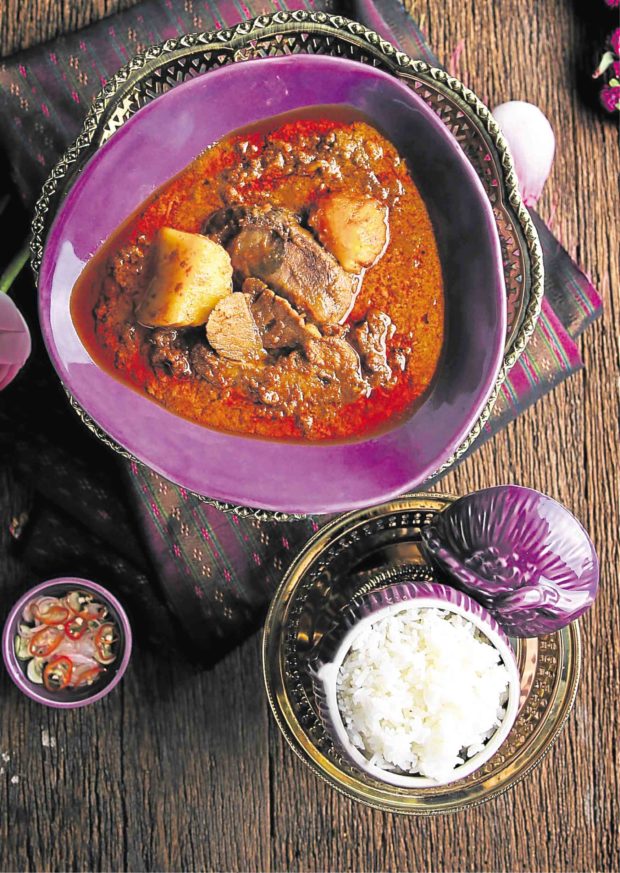
Thai cooking and my taste buds have a long history. My very first taste of Thai cuisine was at the first Flavors and Spices of Ad Lim at Mile Long in Makati. Her Thai chef thrilled customers like Conrad Calalang (who ran Barasoain restaurant also in Mile Long), author Gilda Cordero Fernando and cookery teacher Maur Aquino Lichauco.
I tried the really spicy dishes and sniffed throughout the meal. I left teary-eyed from all the spices. When Flavors and Spices expanded to several restaurants, I noticed how tame those dishes became, and that the flavors were not the same.
Later I took up Thai cooking lessons in Bangkok. At Oriental Cooking School, I had a most unforgettable funny teacher called San. The lunches I had there remain the best Thai cooking I’ve tasted.
From that five-star venue, I found street food to be as good. I enjoyed roti on a side street of the Oriental, the papaya salad from a woman vendor on the main Bangkok highway, and the satti in a beer festival in front of a mall. I got to sample the lechon near the Chatuchak market on succeeding trips.
Sometimes, visiting chefs in Manila take us back in time to Bangkok with their delectable cooking in high-end hotels. But the tasting sessions have been few and far between.
Recently, I dined at Nara and was exhilarated that there’s good authentic Thai cooking in Manila. Nara is at the Fashion Hall in SM Megamall.
Thai recognition
My estimation of the restaurant was reinforced when it received the Thai Select Seal, a recognition that Nara serves authentic Thai cuisine. Thai Ambassador to the Philippines Vasin Ruangprateepsaeng presented the seal to Nara owner Sheila Bermudez Romero.
Her restaurant is a Thai franchise, and Romero said franchise owners insist on a menu of dishes that follow the original recipes, not adjusted to local taste preferences.
A Thai chef flies to Manila from Bangkok to train Filipino chefs, and visits often to check on the cooking. Some ingredients found only in Thailand are also brought in. And the look of the place adheres to the Nara design evoking Thai culture.
We were overwhelmed by how much food was served in celebration. There were a dozen dishes, all of them familiar to me by now.
We zeroed in on the pad Thai kai krob, the noodles with prawns and crisp egg floss because it was a dish dearly missed.
We cleansed our palate with the pomelo salad (yum sum), then dug into the rich, flavorful massaman beef curry, opting as well for white rice to go with it, so as not to confuse the palate if we had the two fried rice options offered—pineapple fried rice and the one Filipinos call “bagoong rice” (khao phad nam prik goong seab).
The two seafood dishes were stir-fried squid in salted egg (pla muk pad kai khem) and stir-fried crab with yellow curry sauce (phu phad pong karee).
The staff kept apologizing that they couldn’t serve grouper that day. No one minded because we were too full to even finish our desserts of rice dumplings with salted egg in coconut milk, and the longan sticky rice also with coconut milk.
I have heard of customers who want their orders not too spicy or too sweet. That presents a problem for the restaurant, which will serve only authentic Thai cuisine based on the recipes of the mother restaurant in Thailand. It also wants to maintain its status as recipient of the Thai Select Seal.
In Bangkok, I was guilty of asking the papaya salad vendor to put just one chili in the mix. She obliged. I believed she knew that toning down the spiciness wouldn’t alter the taste. But if I asked her not to place the raw crab fat in the mix, she would have found it unforgivable.
E-mail the columnist at pinoyfood04@yahoo.com.